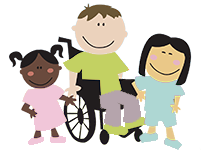Now, with more children being diagnosed with autism, many parents are curious as to the symptoms and characteristics of the disorder. The Diagnostic and Statistical Manual of Mental Disorders, DSM-III outlines the diagnostic criteria for autism. Autism is a brain disorder characterized by impaired social communication and interaction as well as restricted or repetitive behaviors. Parents typically notice these symptoms within the first 2 years of a child’s life.
 The main hallmark of autism is impaired social interaction. While in typical development, children seek out interaction with others, children with autism can either fail to be responsive to others or develop normally and then regress to becoming less responsive to those in his/her environment. It is common for children with autism to have poor eye contact as well as difficulty understanding others emotions.
The main hallmark of autism is impaired social interaction. While in typical development, children seek out interaction with others, children with autism can either fail to be responsive to others or develop normally and then regress to becoming less responsive to those in his/her environment. It is common for children with autism to have poor eye contact as well as difficulty understanding others emotions.
Restricted or impaired communication is another characteristic of autism. Often children with autism have little or no verbal communication. They might have immediate echolalia or pronoun confusions. They can also have abnormal speech production, such as a high-pitch or monotone voice. Their nonverbal communication is also impaired, including their eye gaze, pointing, and gesturing.
Repetitive movements is another characteristic common in children with autism. This could include rocking, hand flapping, spinning, or head banging. They can also have a restricted range of interest, such as lining up objects or spinning the wheels of a car.
Like many disorders, children can exhibit a wide range of symptoms, and autism falls under a group of developmental disorders known as autism spectrum disorders (ASD). Parents should have their child evaluated by a professional if they see any of the following signs:
- Difficulty making friends or interacting with peers
- Difficulty making conversation with others or taking turns in conversation
- Lack of social play and symbolic play or exhibits abnormal play
- Abnormal language form or content
- Preoccupation with parts or certain objects
- Marked lack of awareness of the feelings of others
- Difficulty with transitions or strict adherence to routines
Children with autism exhibit a wide range of behaviors including echolalia, idiosyncratic language, fascination with mechanical objects, or unusual motor behaviors. They have marked impairments in communication and should be seen by a speech-language pathologist trained in working with those with autism to improve their ability to interact with others in their daily lives.
Please visit us at Speech & Occupational Therapy of North Texas
